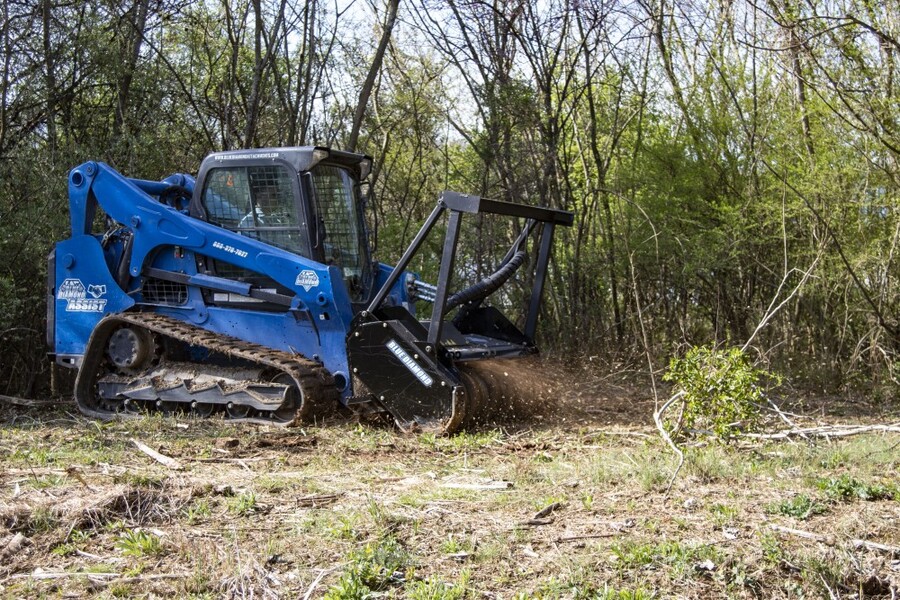How To Choose the Best Forestry Mulcher For Your Skid Steer?

Table of Content
1. Understanding Your Skid Steer Requirements
2. Heavy Duty Construction for Demanding Applications
3. Drum vs. Disc Mulcher Attachment Options
4. Critical Factors for Forestry Operations
5. Maintenance and Operational Considerations
6. Find Your Skid Steer Forestry Mulcher At Skidsteers.com
When it comes to land clearing and vegetation management, few pieces of equipment can match the efficiency and versatility of a skid steer forestry mulcher. Whether you're tackling dense brush, cutting through trees, or preparing a site for development, choosing the right mulcher attachment can make the difference between a successful project and a frustrating experience.
Understanding Your Skid Steer Requirements
Before selecting any mulcher attachment, it's crucial to evaluate your skid steer's capabilities. The hydraulic flow rate, operating weight, and lift capacity of your machine will determine which mulcher will provide optimal performance. Most high-performance forestry mulchers require high-flow skid steers delivering between 30–45 GPM to effectively mulch material up to 6–8 inches in diameter.
The hydraulic motor speed and pressure specifications must match your skid steer's output to ensure maximum productivity. A mismatch between your machine's hydraulic capabilities and the mulcher's requirements will result in poor performance and potential equipment damage.
Heavy Duty Construction for Demanding Applications
Professional land clearing demands equipment built to withstand extreme conditions. Look for mulchers made with heavy-duty materials and designed to protect critical components from debris and impact damage. The motor housing should be built to standard specifications that provide durability while maintaining optimal cutting performance.
Quality mulchers feature reinforced push bars and cutting chambers designed to handle the variety of materials encountered in forestry applications. These heavy-duty components ensure your investment will provide years of reliable service across different job sites.
Drum vs. Disc Mulcher Attachment Options
The choice between drum and disc mulchers depends on your specific application needs:
Drum Mulchers excel in applications requiring fine mulching material and precise control. They can cut material up to 12 inches in diameter and work effectively below ground level for stump removal. The drum design provides better visibility and maneuverability, making them ideal for urban applications where debris control is essential.
Disc Mulchers offer faster cutting speeds and can handle larger material up to 14 inches in diameter. They're designed for rapid land clearing where productivity takes precedence over material fineness. The disc configuration allows for quicker work completion but produces larger mulch debris.
Critical Factors for Forestry Operations
Cutting Width and Performance
The cutting width of your mulcher attachment directly impacts productivity. Standard cutting widths typically range from 44 to 78 inches. While wider cutting heads complete jobs faster, they require larger machines and may limit access in tight spaces. Consider your typical job site conditions when selecting the optimal width.
Teeth Selection for Maximum Durability
Choosing the right teeth is essential for both performance and maintenance costs. Chipping teeth provide superior mulching action and are more available at lower costs, making them ideal for standard forestry work. However, when working in rocky soil conditions, carbide teeth offer the durability needed to protect your investment and maintain cutting efficiency. Some mulchers allow interchangeable tooth systems (e.g., carbide and steel), offering flexibility based on terrain.
Hydraulic System Compatibility
The hydraulic flow and pressure requirements must match your skid steer's capabilities. High-flow systems running at optimal pressure provide the speed and torque necessary for efficient cutting. Ensure your machine can provide the specific hydraulic requirements without compromising other functions.
Maintenance and Operational Considerations
Regular maintenance is crucial for preserving performance and extending equipment life. Look for mulchers designed with easy access to key components for routine maintenance. Quality attachments feature serviceable parts that can be replaced on-site, minimizing downtime and maximizing productivity.
Consider the availability of replacement parts and service support in your area. Equipment that's well-supported by dealers and service networks will provide better long-term value and reduced operational costs.
Find Your Skid Steer Forestry Mulcher At Skidsteers.com
Selecting the best skid steer forestry mulcher requires careful consideration of your specific needs, machine capabilities, and operational requirements. Evaluate the material types you'll encounter, the desired mulch fineness, and the terrain conditions where you'll be working.
At skidsteers.com, our equipment specialists can provide detailed specifications and help match the right mulcher to your skid steer and application needs. The right combination of machine and attachment will deliver the performance, efficiency, and reliability your business demands.
Investing in quality forestry mulching equipment pays dividends in productivity, reduced maintenance costs, and job completion speed. Browse our comprehensive selection of mulcher attachments at skidsteers.com and choose the equipment that will provide optimal results for your specific applications.
